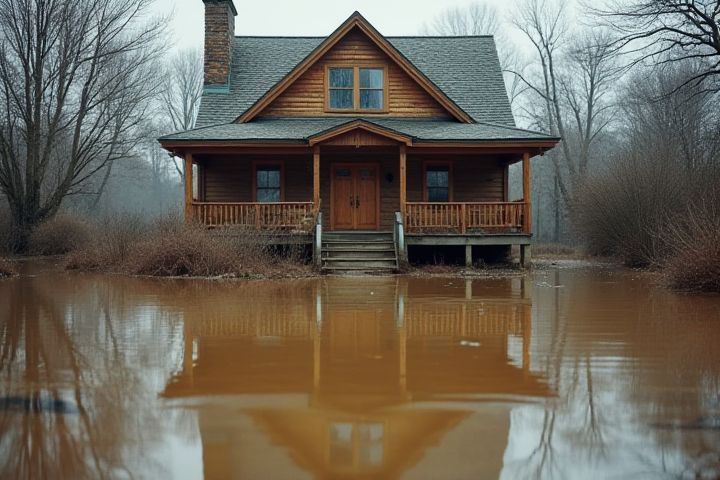
Flooding in a house can be caused by various factors such as heavy rainfall, poor drainage systems, and structural weaknesses. Severe weather events, including hurricanes or thunderstorms, can lead to excessive rainfall and surface runoff, overwhelming the ground's absorption capacity. Clogged gutters and drains can prevent water from flowing away from your home, contributing to localized flooding. Additionally, plumbing failures, such as burst pipes or sewer backups, can introduce significant amounts of water into your living space. Lastly, a rising water table, especially in low-lying areas, can cause groundwater to seep into basements and foundations, increasing the risk of water damage.
What Causes A House To Flood
Heavy rainfall
Heavy rainfall is a primary cause of flooding in homes, often leading to overwhelmed drainage systems and rising water levels. When precipitation exceeds the soil's absorption capacity, excess water can pool around foundations or infiltrate basements. Your property's location also plays a significant role; homes in low-lying areas or near bodies of water are particularly vulnerable. Furthermore, inadequate drainage systems, such as clogged gutters or improperly designed landscapes, can exacerbate the risk of flooding during intense storms.
Storm surges
Storm surges occur during severe weather events, particularly hurricanes and tropical storms, when strong winds push seawater onto land, often leading to flooding. Coastal areas are especially vulnerable, as surges can raise water levels significantly--sometimes exceeding 20 feet in extreme cases. Factors such as high tide, shallow coastal waters, and the geography of the shoreline can exacerbate the impact of a storm surge, resulting in widespread inundation. Understanding these dynamics is crucial for homeowners living in susceptible regions to take appropriate precautions and safeguard their properties against potential flooding.
Flash floods
Flash floods are primarily caused by intense rainfall within a short period, often exceeding 1 inch per hour, overpowering the ground's absorption capacity. Urban areas with inadequate drainage systems can exacerbate the situation by channeling water into streets and properties. Additionally, sudden snowmelt combined with heavy rainfall can significantly elevate river levels, leading to rapid flooding. Topography plays a critical role, as regions with steep slopes can accelerate water flow, resulting in a swift rise of floodwaters in vulnerable homes.
River overflow
River overflow, often resulting from heavy rainfall or rapid snowmelt, can lead to significant flooding in surrounding homes. When water levels rise above the riverbanks, it can inundate adjacent areas, with some regions facing flood depths exceeding six feet. Urban development often exacerbates this issue, as paved surfaces prevent natural absorption and redirect rainfall towards waterways, increasing the potential for overflow. Maintaining proper drainage systems and adhering to floodplain regulations are crucial for minimizing the risk of your home experiencing flood damage during such events.
Dam or levee failure
Dam and levee failures are significant contributors to residential flooding, often resulting from a combination of structural weaknesses, extreme weather conditions, or inadequate maintenance. When a dam ruptures, the sudden release of water can inundate surrounding areas, overpowering local drainage systems. Similarly, levees may fail under the pressure of prolonged heavy rainfall or storm surges, allowing river or ocean waters to spill into neighborhoods. Homeowners near these structures should be aware of potential risks and ensure that proper flood insurance and emergency plans are in place to mitigate the impact of such disasters.
Blocked drainage systems
Blocked drainage systems are a leading cause of flooding in residential properties, as they hinder the proper flow of water away from your home. When debris, such as leaves, soil, or other obstructions accumulate, the drainage capacity can dramatically decrease, causing water to overflow during heavy rain or storms. Statistics indicate that clogged gutters and downspouts account for approximately 70% of all home flooding incidents, emphasizing the importance of regular maintenance. Inspecting and cleaning your drainage systems at least twice a year can significantly reduce the risk of water damage and costly repairs.
Melting snow
Melting snow can significantly contribute to house flooding, especially during rapid temperature increases in spring. When daytime temperatures rise above freezing, accumulated snow can melt quickly, leading to a sudden influx of water. This water can overwhelm drainage systems, especially if the ground remains frozen or saturated from previous precipitation, preventing proper absorption. Homeowners in regions with heavy snowfall should monitor melting patterns and consider implementing drainage solutions to mitigate flood risk.
Broken water mains
Broken water mains are a significant cause of flooding in residential areas, often leading to extensive water damage. When a water main breaks, it can release thousands of gallons of water per minute, overwhelming drainage systems and saturating the surrounding soil. In urban settings, this can lead to rapid street flooding, making roads impassable and affecting local infrastructure. Homeowners should be aware that even minor breaks can escalate into major issues, resulting in costly repairs and potential loss of property value.
Poor landscaping
Poor landscaping significantly contributes to house flooding by disrupting natural water drainage patterns. Inadequate grading can direct rainwater toward your foundation instead of away from it, increasing the risk of water pooling. Overgrown plants and trees can impede the flow of water, while dense soil compaction reduces drainage capacity. Implementing water-smart landscape design, such as rain gardens or proper elevation, can mitigate flooding risks effectively.
Groundwater rise
Groundwater rise can be primarily caused by prolonged periods of heavy rainfall or rapid snowmelt, leading to saturated soil that cannot absorb additional water. When the water table elevates beyond its normal level, it can infiltrate through foundation walls or cracks, flooding basements and lower levels of homes. The presence of impermeable surfaces like concrete and asphalt can exacerbate the situation by directing water runoff towards your property rather than allowing it to seep into the ground. Over time, continuous groundwater rise can also result from a decline in water extraction from wells, altering natural hydrological patterns and increasing flood risk in residential areas.
